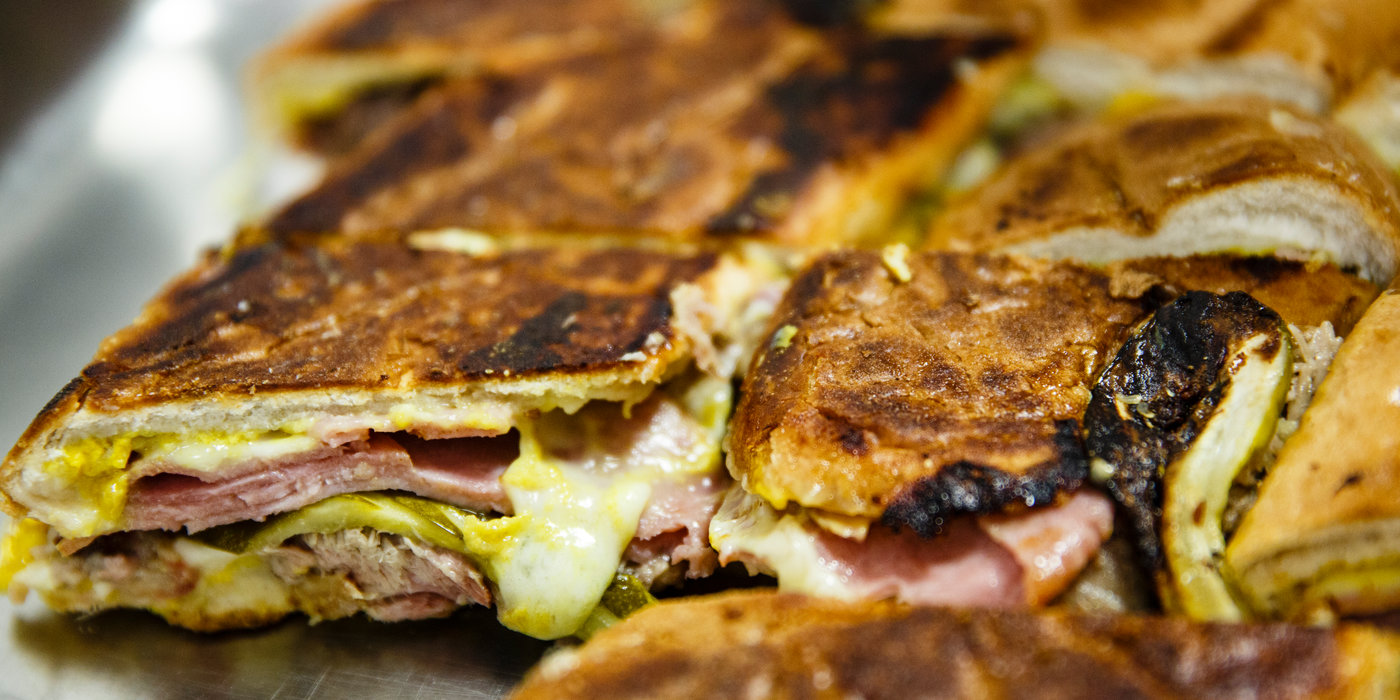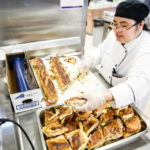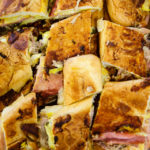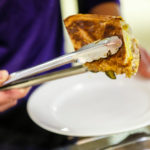It’s 8:59 on Thursday morning, and Angel Quilli is whipping down slices of ham like a blackjack dealer.
Spread out before Quilli – one of the many chefs at The View – are the bottom halves of 20 loaves of French bread. Each is the base of Cubano sandwiches that will be served tomorrow for lunch at the World Eats station. On top of this bready base Quilli layers ingredients as if he’s building small walls, piling upward brick by delicious brick: Down goes the mustard. Down goes the Swiss cheese. The pulled pork. The pickles. The ham. More cheese. More mustard. More bread. Even with cold ingredients, the smells are fantastic.
“These aren’t hard to do, but it takes time. These are more American-style Cubanos,” said Quilli, who hails from Ecuador. “I like my Cubanos with mayo and a lot more spices, but we’ve got to follow the recipe. Students don’t like [foods] as spicy as I do.”
Each food’s elements – spices, ingredients, the weights of each – are drawn directly from a recipe, where the life of these Cubanos – and every other dish served at The View – begins. So, let me back up from Quilli’s tantalizing tabletop and introduce you to Jonathan Empie and Andrea Cossetta. A registered dietician, Cossetta has led The View’s efforts in the past year and a half to develop recipes (including for Cubanos) for a new six-week menu that hits as many of the major boxes (taste, health benefits, visual appeal, variety, allergy awareness, etc.) as possible to satisfy a hungry horde of students, faculty, staff and visitors over breakfast, lunch and dinner.
“It is hard to plan a menu for so many different preferences,” she said. “You’ll never get to that point where everyone is completely satisfied, but you can get pretty close.”
Cossetta works in lockstep with Empie, assistant director of budget and systems, and other employees at The View to transition menu conceptions into concrete recipes and service schedules. Included in that are specific details about how much of each ingredient it takes to make each serving, but the difficulty comes in forecasting how much of each food to make. How many people are going to eat at The View on the day this particular food is being served? How many people who come are going to eat this particular food?
Based on several factors, Empie and others forecast how much of each ingredient should be ordered and how many servings should be prepared. All of this is tracked in Food Service Suite, the digital space where everything in the food preparation process for The View is kept. Following a single recipe such as Cubanos through the ordering, delivery and preparation process gives a feel for what the path looks like, but it’s worth bearing in mind that it’s the same for dozens of foods every day; all told The View deals in millions of dollars of food each year, Empie said. It’s not exactly a small operation.
Like most food service, though, everything is broken into individual chunks: Once a meal is set on the schedule and a forecast is set for how much of it will be needed, ingredients are ordered days ahead of time, creating a constant cycle of delivery, preparation and serving. At the beginning of the week chefs look into the upcoming days’ set of meals in a detailed recipe book that's specific to that meal's forecasted number of servings. (Some meals are prepped immediately before being served, while others are prepared ahead of time and refrigerated.)
In the case of the Cubanos, the latter option saw Quilli standing in his white shirt and black pants in the kitchen’s back prep area on Thursday morning, building 40 loaves' worth of sandwiches for the next day’s lunch. On Friday, chef Ericka Boice took those loaves out front onto the main dining floor, where she laid out several at a time onto the station’s tabletop grill. She and sous chef Dan Schmitz put large silver pans on top of the sandwiches to help give them their characteristic flat, panini-like makeup. (Depending on if it’s professional chefs or students preparing meals out front, Schmitz said there can be some training necessary for how to cook things properly.)
In Boice’s case, she had no problem rotating loaves through cooking and immediately cutting and loading them into the heated serving trays that diners would pull from. “Bite sized” was the approximation Boice said she was looking to offer, which ended up meaning about eight, 2-inch wide servings from each of Quilli’s loaves. As Boice cut and Schmitz loaded new loaves onto the grill, the smell of toasting bread, sizzling meat and melting cheese blended together as the countdown to 11 a.m. and lunch beginning came down to its final minutes.
“We want stuff that looks good, smells good and obviously tastes good,” Schmitz said. “These are definitely that.”
It didn’t take long after The View’s doors opened for several patrons to find their way to the Cubanos station, including freshman Noah Larson.
“I had never had one before I had one here last semester. They’re really good,” said Larson, mentioning that he enjoyed the opportunity to try new foods at the World Eats station. “I had never had curry before I had it here, too, and it’s one of my favorite foods now.”
Reviews like that are exactly what employees at The View are looking for as they gauge what offerings are successful and what aren’t: Empie and Cossetta said they rely on everything from anecdotal evidence from employees and patrons to waste levels after meals. All told, it’s a constant, evolving cycle at The View, from the moment an offering is conceived; to its recipe development; to its ingredient ordering, preparation and serving; to the moment someone like Larson bites down into it.
“We just have to make good food,” Quilli said. “We want these students [and other patrons] to like what we’re doing here.”










